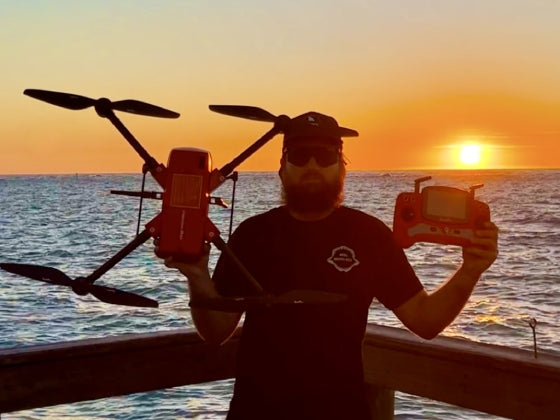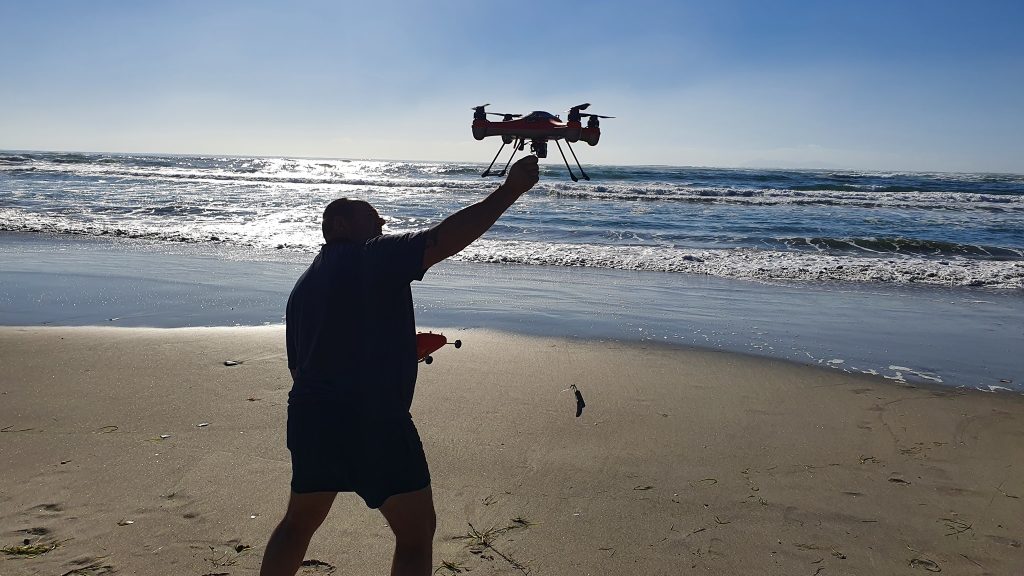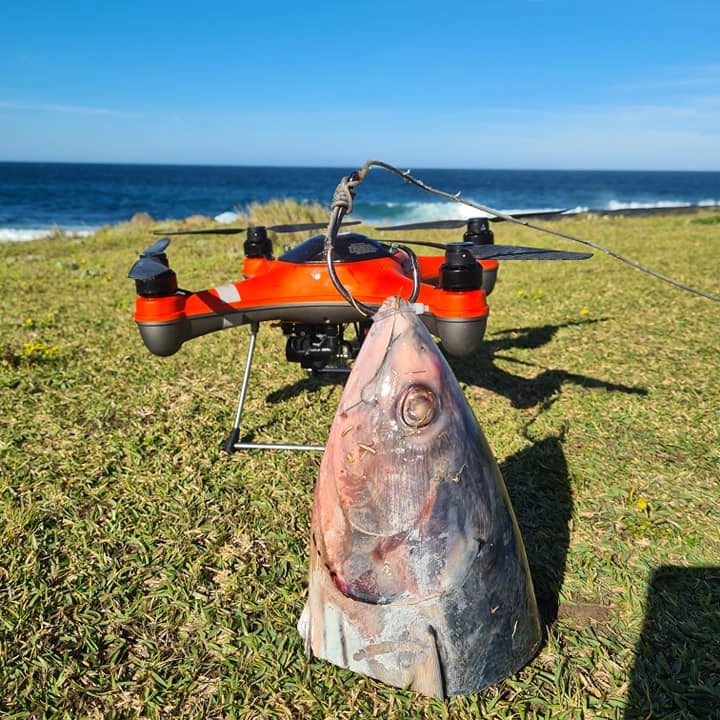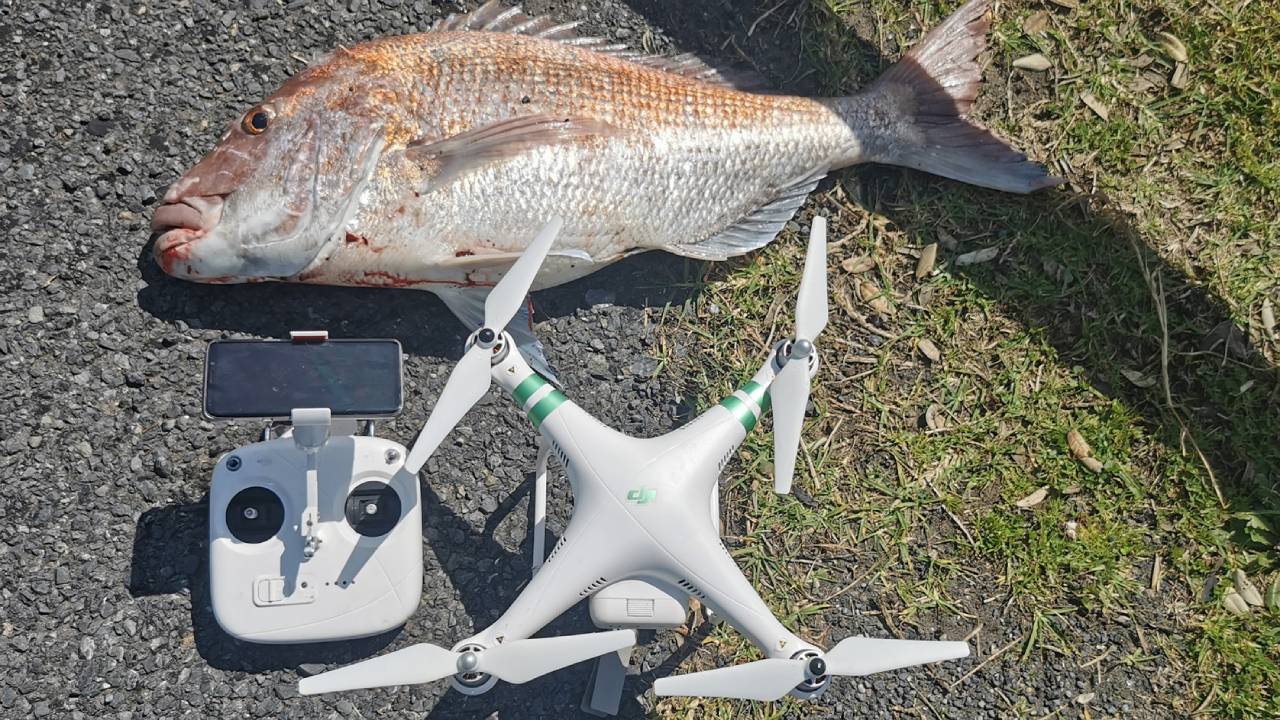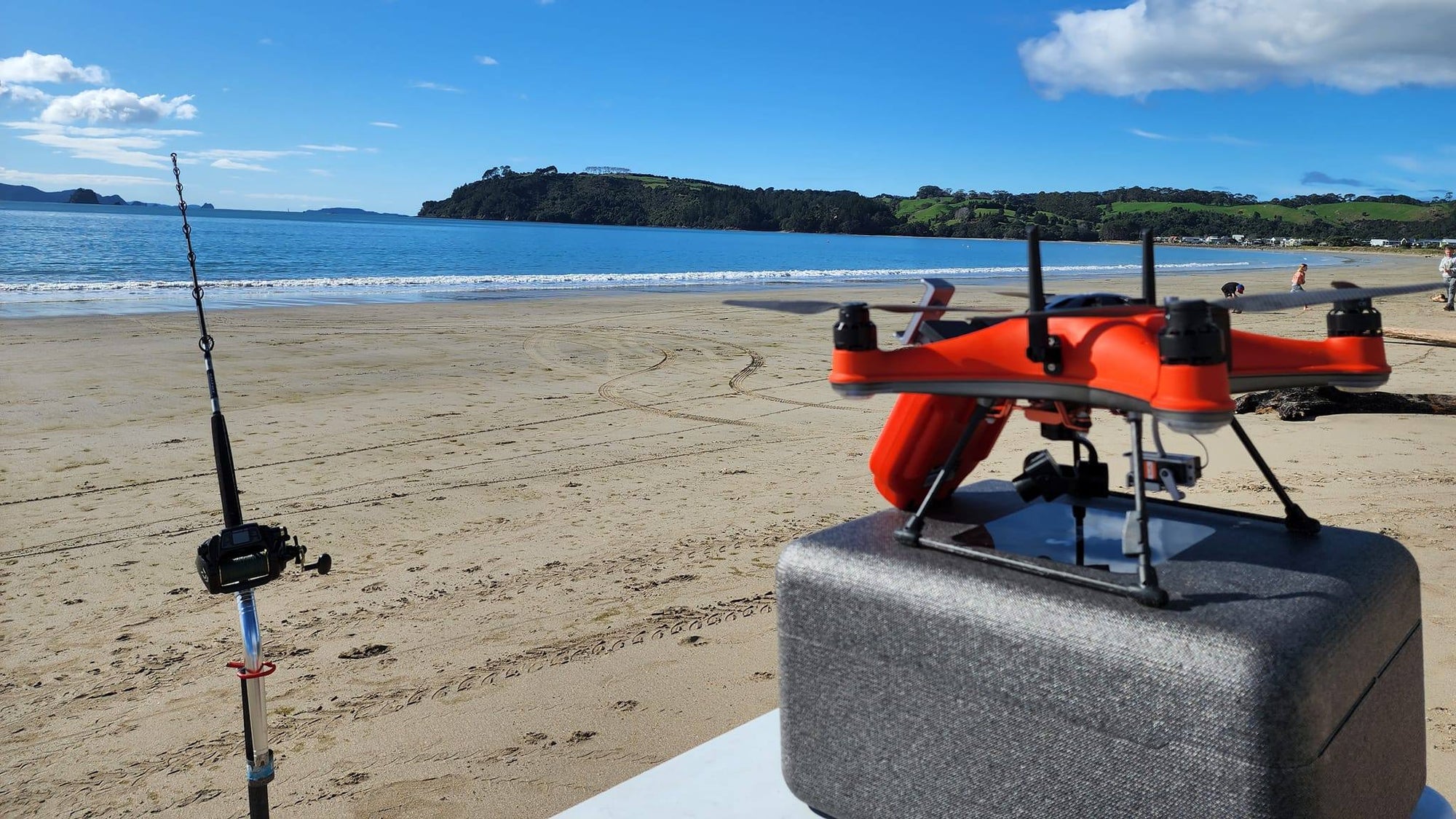Drone fishing is exactly what it sounds like, you’re using your drone to both scout and fish from the water area around you. Needless to say, it’s far more efficient than traditional fishing and saves much more time (although some fishermen think it takes the fun out of fishing).
In case you’re wondering what that looks like, check out this video below.
Drones are used for fishing in two main ways: scouting from the air to locate fish in the water below (and know where to drop your bait), and dropping the bait in the water from the shoreline or boat, allowing you to cast the bait much farther.
This article will be a comprehensive guide on drone fishing. We’ll go over which drones you should use and how to use them. Let’s get into it.
What Do You Need for Drone Fishing?
So, what do you need? First you need a drone (obviously), but not just any drone. The kind of drone we’re looking for has some weight to it (to resist the sea shore wind), can handle a payload of up to 1 kilogram (to carry large baits), and most of all is waterproof.
I’m adding waterproof as an important trait because unless you’re a real pro, chances are you’ll likely drop your drone in the water at some point.
Then we’re going to need a bait release mechanism, this allows you to remotely drop the bait at your point of choice in the water. We’ll go over where to get these in a moment.
And lastly, you’ll still need what every fisherman would need: rods, reels and lines.
Let’s start with the drones, I’ve made a list of my top 3 recommendations for fishing…
Drones That Can be Used for Fishing

Splashdrone 4
Splashdrone 4 is a waterproof drone that’s used for not just fishing, but everything that involves water really, so you can expect it to be made of higher quality material than regular drones.
It’s made with industrial-grade ABS plastic, and every part of it has been sealed to make it 100 percent waterproof. It can also float, and do a powerflip within the water before taking flight again, making it perfect for fishing aficionados that aren’t quite experienced with drones.
Without load its flight time is 30 minutes, but expect it to be around 20-25 minutes with the bait’s weight.
Here is where it gets interesting, its maximum payload capacity is 2 kilograms. That’s extremely practical if you’re going after fish that require heavy baits (like sharks).
The remote controller is also waterproof, in case you’re fishing from a boat and you drop it.
Needless, this is an amphibious drone that shines best above the water.

The Fisherman FD1
Just from its name, you can tell that the Fisherman FD1 is specifically designed for drone fishing. Made by the same company as Splashdrone 4, this drone from Swellpro comes as a more beginner-friendly version of the splashdrone.
They basically took the Splashdrone 4, and removed all the bells and whistles that don’t contribute to bait dropping. With a stronger propulsion system, Fisherman FD1 has higher bait lit capacity, longer flight time and better wind resistance than SplashDrone 4. Making it excel at being a fishing drone.
It also has a 30 minutes flight time, 2 kg of payload capacity and needless to say, is also waterproof. What this drone doesn’t have is a camera, which may be a turn off for some, especially if you like to record your fishing sessions.

Spry+
The Spry+ drone is yet another waterproof drone, also able to float in the water. There is a big difference between this drone and the ones above though. This is traditionally an aerial photography/videography drone, which can also be used as an fpv racing drone.
It’s also light and doesn’t support that big of a payload, so why did I add it to the list?
Simply put, it’s really good if you’re using small baits. Especially if you’re fishing in an area where speed counts a lot.
It can also take great shots and flying is really fun as it’s also made for FPV racing. Though if that’s irrelevant to you and you’re only interested in practicality, I’d recommend one of the two drones above.
Types of Drone Bait Release Mechanisms
This is really important. A bait release mechanism is the mechanism that allows you to remotely let go of (drop) the bait on your location of choice, once the drone is hovering where you want it to.
Obviously you do not want to mess this up. If the mechanism isn’t working properly, it might offset the balance of your drone, causing it to crash.
While there are DIY ways to make a mechanism (I’ll cover them later in this article), the best way to go about it is to get yourself an already manufactured one.

Remote controlled bait release
Splashdrone 4 has a specific payload dropping mechanism called the PL1-S. What’s good about it is that it can be programmed to drop the bait remotely via the Swellpro SDFly App, contrary to the abrupt pulling you have to do with some manual payload droppers. It’s also affordable at only $69.
Since we spoke about the Fisherman FD1, it’s only fair to talk about its specific bait dropping mechanism. The PL2-F is not only a remote payload release device, but also an external camera, allowing you to get the best of both worlds: The camera of the Splashdrone 4 and the practicality of the Fisherman FD1.

Self-tension bait release
Self-tension bait releases work manually, and utilize pre-set tension to release your drone (usually triggered by stopping the drone’s flight or by abrupt movement).If hover and troll fishing appeals to you, and you just want to have fun dangling baits above the water, then the Spry+ is for you.
You can get the TrollSafe bait release mechanism that’s specifically for the Spry+. It only weighs about 8.5 grams and is very budget-friendly at only $19.
Best rods for drone fishing
There is no specific answer here; it largely depends on your preferences, which area you’re fishing in, and what type of fish.For instance, you may find a shorter rod to be more suitable for you, while someone else who’s fishing sharks on a sea shore will find themselves needing a longer and sturdier rod.
That being said, here is my rod recommendation, as well as the reason behind it.
Tica Traveller 704 4pc 24kg Boat Rod
More and more fishermen travel many miles to take on the largest tropical species. This poses a problem, as most boat rods are single or 2-pce, making travelling with them difficult. To solve this problem, TiCA now offers a 24kg game rod made with a 4-pce blank, the rod packs down to a neat 590mm to fit your luggage.Penn Ocean Assassin 5ft 5 in 1pc Game 24kg Deep Drop Bent Butt Swivel Tip
This is perfect for drone fishing if you’re using braid. PENN Ocean Assassin Game rods feature SLS3 blank construction, it uses inner and outer spiral wrap layers of carbon fibre to sandwich middle layers of alternating longitudinal carbon and glass.Oannes Valkyrie 12ft 40-60lb Drone/Surf Rod
Valkyrie is designed primarily for drone fishing which is why it's on the list. It has a high modulus carbon fibre three-piece fishing rod with an overall length of 12ft. It also has an awesome casting ability for surf fishing.
Best reels for drone fishing
If we’re talking about reels, then it’s entirely based on which type of fishing you’ll be doing. Are you fishing in a lake or on the sea shore where you’d need a sturdier reel? Are you fishing small game or big ocean predators?While it’s highly objective, I still have a list of some reels that I think are at the top when it comes to fishing with a drone. Starting with…
Tica Hyena HN100 8RRB 3.3:1 Surf Reel
Pairs perfectly with the Tica travel rod we discussed above. If you're looking for a magnum sized, top-quality and high performing surf fishing reel with an accessible price tag, the Tica HN100 offers the best value in surf spinning reels of this size.
Alvey 82GVCN2 Deep Drop Reel
A modern and fully vented injection moulded reel, with a graphite back and a strong metal foot and a fibreglass spool. The sporty off-set laser cut handle plate gives a choice of recovery rates, making this reel perfect for fishing bigger game.Shimano DDM Plays 4000 Electric Reel
The Shimano Plays 4000 reel has HAGANE BODY technology, meaning more rigid tolerances and a stronger frame that reduces twist under load. This reel is ideal for the smaller SPRY+ size drones.Lines for drone fishing
When it comes to drone fishing, ideally you want a line that has a very small diameter and high breaking strains to enable a greater quantity of line to be spooled to the reel.
The smaller diameter line comes into play when you consider the amount of line the average drone drop requires, as it reduces wind drag and (a lower PE line makes a massive difference).
How long should a fishing line be?
Ideally you need a minimum of 500 metres of line in my opinion. Shoot for 700 metres as that’s optimal, while a SplashDrone 4 drone has a range of 5 km, you’ll still be limited by your fishing line.
What braid size to use for drone fishing?
In case you’re using a braid when drone fishing, get yourself one that has a low PE with break strain ratings that are relevant to the rod used.
Another important factor to consider when regarding braids is their abrasion resistance and quality. The braid should be silky smooth to limit reel bind and reduce heat on retrievals over large distances.
How to rig your drone for fishing
Since you’re fishing with a drone, you’ll need a bait release device for your line. Devices like PL1-S and the PL2-F are great because they reduce the danger to your drone, that’s usually associated with manual bait releasers.
You’ll want to take your time in this step in particular and make sure you do it right. Otherwise it can easily mess with the balance of your drone. This video explains the process from scratch perfectly, using the PL1-S bait releaser:
Using your drone to scout for fish
Besides bait dropping, scouting for fish is also a common drone use in the world of fishing. Especially if the drone in question has a good camera and a good transmission system.
The reason for that is simple: drones have the advantage of a top-down perspective, they see a wider coverage area, and have a clearer view than simply looking from your boat.
While traditionally you can only see a few meters away horizontally when looking for fish, by using a drone you can actually cover a very wide area.
Looking through the camera of a drone also allows you to spot schools of fish from the air much more easily than you can from the deck of a boat, making it easier for you to study their habits and predicting where they might end up.
You can also better spot things like logs if you’re in a lake, get a clear idea on the condition of the water and know exactly whether you’re in a primea area or whether you should switch spots.

There is another way to use your drone to scout for fish, sometimes better than using the camera, and that’s by using sonars. If that sounds too advanced, don’t worry, it’s not. It’s actually really easy to use.
Swellpro’s Dronar for example is a flyable and castable wireless sonar fish finder. It can be hitched to the SplashDrone 4, Dronar can detect fish and send fish visuals to your smartphone from up to 1 miles (1.5km) away.
Using a Drone to Fish from a Boat
As we’ve discussed, drone fishing helps you scout a larger area for fish and also drop your bait in places you can’t reach otherwise.
You might think that by having a boat, you don’t need to drop bait using a drone. You can just move to the area of your choosing. You’d be right, but you’d also be forgetting that the advantage of drones lies in dropping the bait without your or your boat alerting the fish in the water.
While silent drones don’t exist, drones likes Splashdrone 4 and Fisherman FD1 are still more quiet compared to the perturbation a boat does in the water.
Drones also have the remarkable feature of “fly home”. Which means, once you drop the bait, or if a fish ends up taking the bait, you don’t need to worry about your drone. You can just click the fly home button and it’ll land wherever the remote controller is, which is on your boat.
Drone fishing without a rod
It’s definitely possible, and a lot of fun. But also risk (by risky, I mean expensive since you may lose your drone).
To do it, simply tie your light fishing line to your drone (with a bait of course), fly over the area where you suspect the fish to be and wait. This is called hover fishing and can be done with drones like the Spry+.
The problem is that you don’t know when the fish will take the bait, and the battery life of drones is very limited. You also run the risk of pulling a large fish that’s either too heavy for your drone or too feisty and keeps pulling.
As fun as it is, be careful if you decide to fish without a rod.
Is it Legal to Fish with a Drone?
Ethical angling is determined (and its rules are dictated) by the International Game Fish Association, back in 1940. I don’t have to tell you but rules regarding drones weren’t determined back then.
That being said, each state within the US, and each country worldwide can also create their own laws as to how fishing can be done.
According to the International Game Fish Association, things such as outriggers and kites may be used to trail baited lines, provided the line releases from the device the moment a fish bites (the same way it’s usually done with a drone). Drones can be used in fishing, so long as you release the line before or upon the event of a fish striking the bait. It is NOT legal to use a drone to pull in a fish that you hooked with a line attached to the drone.

